Shin-Etsu Group and Climate Change
Plan for Realizing Carbon Neutrality by 2050
The Shin-Etsu Group has formulated a plan to reduce greenhouse gas emissions (Scope 1 and Scope 2) to net zero, with the aim of achieving carbon neutrality by 2050.
Our Efforts to Date
1) Efforts to reduce greenhouse gas emissions that are included in the Company’s management
In various economic activities, there is a need to attain both sustainable development and higher living standards while reducing environmental impact. Meanwhile, businesses must strive to keep their cost competitiveness in order to grow. In this light, the Group has long focused on maximizing the efficiency of its resource and energy use. Such efforts will lead to reducing greenhouse gas emissions and are considered highly compatible with carbon neutrality.
A leading example of our initiatives to attain the maximization of efficiency is the polyvinyl chloride (PVC) business. In the 1970s, to sustain our business in the highly competitive domestic PVC industry, our technical team took on the challenge of maximizing efficiency, including in the production of monomers, the raw materials for PVC. In other words, the aim was "to extract the highest possible production volume from the input raw materials" and "to minimize consumption of energy such as electricity and gas.“
Our proprietary PVC manufacturing technology developed and introduced at the Shin-Etsu Chemical Kashima Plant was also introduced to our US subsidiary Shintech Inc., which began production in 1974. It was the former Chairman Chihiro Kanagawa who proposed and planned the Company’s establishment. Since then, Shin-Etsu Chemical's PVC manufacturing technology has been combined with Kanagawa's streamlined management to eliminate waste, and Shintech has kept its costs low enough to stay competitive in the fierce global PVC market. There are no bounds to Kanagawa’s efforts to push the envelope in terms of efficiency. Indeed, we have grown into the world’s largest PVC manufacturer by introducing a stream of innovative technologies to that lift productivity to the utmost in regard to plant construction and expansion.
In 1990 when Kanagawa assumed the position of President of Shin-Etsu Chemical, the rational management and production efforts that Shintech had practiced were reimported to Shin-Etsu Chemical. Under Kanagawa’s leadership, the G-Committee, a committee structure for rationalization, was established in 1992, and Shunichi Koyanagi, Executive Vice President, became the chairman of the committee. The motivated G-Committee worked without rest to rationalize and improve productivity in the manufacturing sector. When current Representative Director, Chairman of the Board Meeting Fumio Akiya succeeded as chairman of the committee in 2004, the G-Committee grew even more active and expanded its scope to include Shin-Etsu Handotai and other group companies. In addition, the G-Committee has achieved significant rationalization every year through synergies with Six Sigma programs1. In fact to date, the committee has handled more than 25,000 rationalization projects for Shin-Etsu Chemical alone, helping to strengthen our global competitiveness.
1 Six Sigma programs
Quality improvement method developed by Motorola in the 1980s. Focusing on processes with quality variation, it is designed to minimize variations within the processes, thereby reducing the incidence of quality defects. This approach has been adopted across the Group.
2) Our reduction results to date
The Group established the medium-term goal in FY2010, which is to “reduce greenhouse gas emissions in terms of intensity to 50% of the FY1990 level by FY2015.” Furthermore, the Group established the new medium-term goal in FY2016, which is to “reduce greenhouse gas emissions in terms of intensity to 45%(i.e. down 55%) of the FY1990 level by FY2025,” and has strived to attain this objective through energy conservation and the introduction of a cogeneration system.
The actual results for the FY2022 are 54.2% (i.e. down 45.8%) from the FY1990 level for the Group, and 46.8% (i.e. down 53.2%) for Shin-Etsu Chemical from the same level.
Energy usage accounts for 94% of the Group's greenhouse gas emissions. Japan's Act on Rationalizing Energy Use (Energy Conservation Law) sets a target of attempting to reduce energy consumption by at least 1% per year in terms of intensity. If the annual reduction is 1% from FY1990, the “to-date” reduction rate in the FY2022 would be approximately 28% compared to the FY1990 level. Our track record of reducing greenhouse gas emissions, however, significantly exceeds the target set by the Energy Conservation Law.
Measures for Achieving Carbon Neutrality by 2050
As mentioned above, the Group has been striving to reduce greenhouse gas emissions in terms of intensity. In addition to the reductions in terms of intensity we have been working on so far, we have formulated a plan to achieve carbon neutrality by cutting greenhouse gas emissions in absolute quantities.
1) Current reduction measures
In addition to further strengthening the initiatives described in the preceding paragraph, we are currently working on the following reduction measures. We will also focus on considering new reduction measures.
| Reduction measures | Details |
| (1)Power-related |
・Reduce CO2 emission factor |
| (2)Improvement and innovation of manufacturing technologies, etc. |
・Improvement of heat recovery capacity |
| (3)Utilization of carbon-neutral natural gas (natural gas with emission credits), hydrogen, etc. |
・Co-firing in cogeneration systems |
| (4)Promotion of recycling |
・Further promotion of recycling of PVC products and rare-earth contained in rare-earth magnets that has already been implemented |
2) Initiatives toward 2050
Measures of the reductions currently supposed are as follows.
| Reduction measures | Details |
| (1)Power-related |
・Carbon neutralization of electricity |
| (2)Utilization of green and blue hydrogen |
・Single fuel firing in cogeneration systems
|
| (3)Continued improvement of manufacturing technologies, etc. |
・Continuous thorough rationalization and efficiency improvement |
| (4)CO2 separation and recovery, and utilization |
・Full-scale introduction of separation and recovery equipment, and utilization of methanation technology |
| (5)Utilization of biomass fuel |
・Power and steam supply through introducing biomass cogeneration systems, etc. |
| (6)Promotion of recycling |
・Establishment of a recycling system for products other than PVC and rare-earth magnets that have already been implemented |
| (7)Carbon offset |
・Examination of a wide range of carbon offsets, including those from tree planting |
The Group's reduction measures
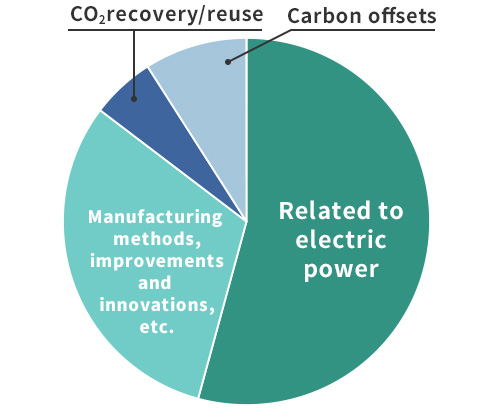
- * “Manufacturing methods, improvements and innovations, etc.” includes the use of hydrogen, use of biomass fuel, and promotion of recycling. “Related to electric power” includes the purchase of renewable energy and the installation of solar power generation equipment.
The components of reduction measures toward 2050 that the Company currently supposes are as described in the above pie chart. We will select the optimal ways to reduce emissions as technology evolves in the future.
As our US subsidiary Shintech Inc., plans to increase its production capacity in the years ahead, the Group’s greenhouse gas emissions are expected to increase around 2025, but then fall as the aforementioned measures take effect.
Other Initiatives to Help Realize a Carbon-Neutral Society
1) Initiatives for carrying out Life Cycle Assessment
By conducting life cycle assessment, the Group will contribute to the reduction of greenhouse gases throughout the supply chain.
2) Reduction of greenhouse gas emissions in logistics
We are working to reduce greenhouse gas emissions during product transportation. This initiative will contribute to the reduction of scope 3 greenhouse gas emissions.
| Reduction in logistics | |
|---|---|
| Examples | Scope 3 emissions categories contributing to reductions |
| Modal shift* in methanol transport(switched from tank truck to railcar) |
Category 4: "Emissions from product transport" |
| Modal shift in silicon wafer transport (switched from aircraft to ocean vessel) |
|
| Modal shift in silicone products transport (swhiched from truck to railcar) |
|
- *Modal shift
Shifting from trucks and other freight transports to railways or ships with less environmental impact.
Shin-Etsu Chemical Naoetsu Plant Certified as Eco-Rail Mark Company
In March 2022, Shin-Etsu Chemical Naoetsu Plant was
certified by the Ministry of Land, Infrastructure, Transport and
Tourism as an Eco-Rail Mark company.
Compared to other modes of transportation, rail cargo transportation is an environmentally
friendly means of
transportation that emits much less CO2. The Eco-Rail Mark is a system that
certifies
companies that are actively
switching to rail cargo transportation as eco-friendly companies. We have been promoting a
modal shift in the
transportation of products from Naoetsu Plant and have now been certified as an Eco-Rail
company because our annual rail
usage volume meets the requirements for certification under the Eco-Rail Mark system.
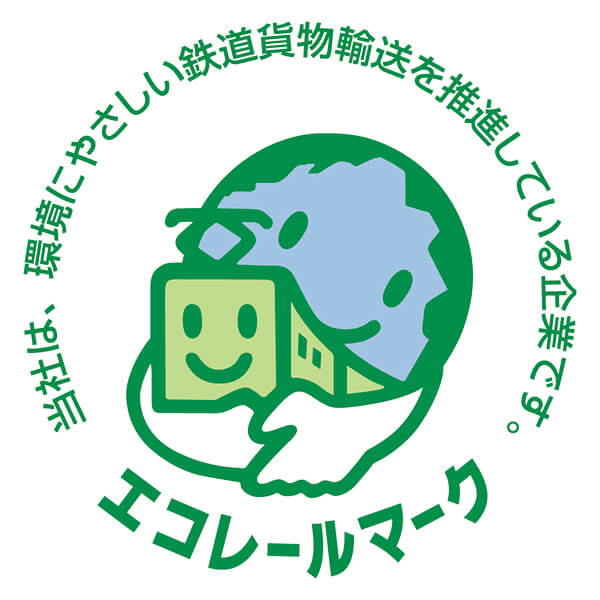
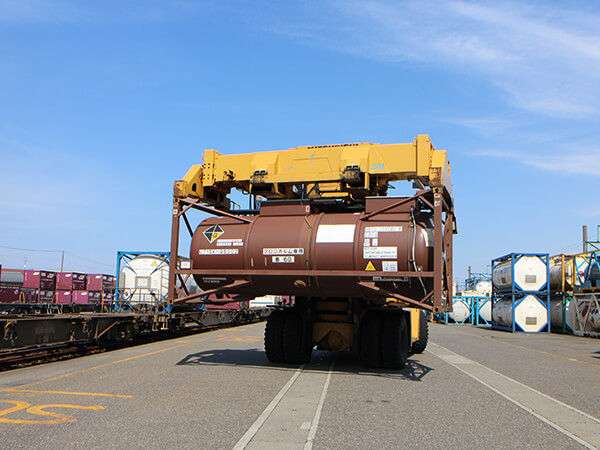
Products being loaded onto freight cars at the freight terminal of JR Freight Kuroi Station.
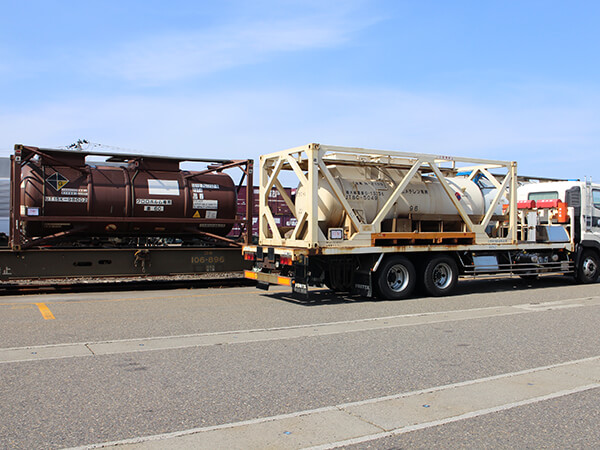
Products are transported from Naoetsu Plant in tank containers on trucks.
3) Expand manufacturing and sales of products that contribute to reducing greenhouse gas emissions
Our group's products are used in a wide range of fields, including housing, infrastructure, electric vehicles, DX and GX, and support the foundations of people’s lives and industries. Many of these products also help reduce greenhouse gases. In June 2021, The Japanese government has identified 14 essential areas to aim for carbon neutrality in 2050. The ratio of sales in these 14 areas to the Group's consolidated sales in FY2022 is approximately 70%. We will continue to contribute to the carbon neutrality of society as a whole by focusing on developing, manufacturing, and expanding sales of these products.
Sustainability > Achieving a Sustainable Society > Comfortable living
14 areas of expected growth
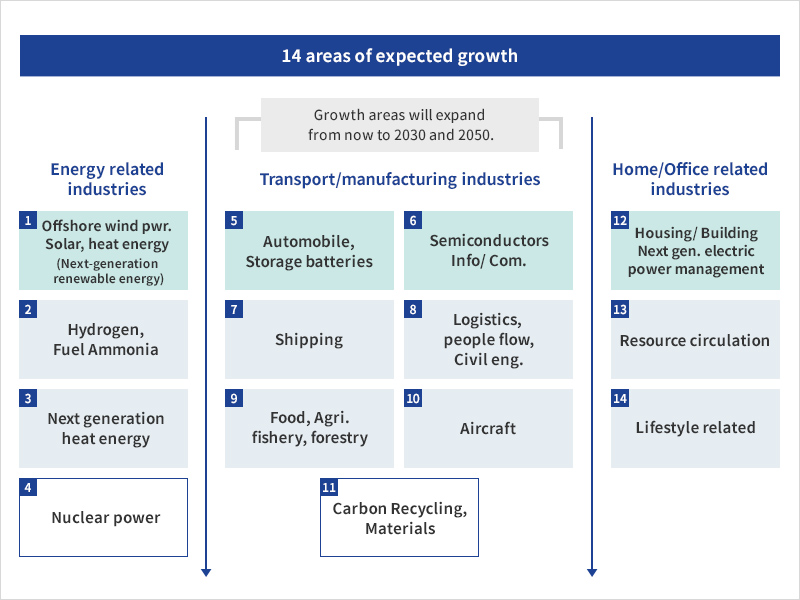
Source: Green Growth Strategy Through Achieving Carbon Neutrality in
2050
(announced by the Japanese government in June
2021)
https://www.meti.go.jp/press/2021/06/20210618005/20210618005-3.pdf
Shin-Etsu Chemical Group Products and Technologies Contributing to the Realization of a Carbon Neutral Society
| 14 areas of expected growth1 | Products and technologies listed in the Green Growth Strategy | Shin-Etsu Chemical Group products and technologies that contribute to green growth strategies2 | |
|---|---|---|---|
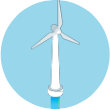
|
(1) Offshore wind, solar and geothermal industries (Next-generation renewable energy) |
・ Offshore wind power generation |
・PVC (wire coating) |

|
(2) Hydrogen and fuel ammonia industry |
・ Hydrogen power generation |
・PVC (wire coating) |
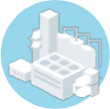
|
(3) Next-generation heat energy industry |
・ Gas decarbonization (e.g., directly using of synthetic methane and hydrogen, introducing LNG with carbon offsets, using CO2separation, recovery and utilization technologies, etc.) |
・Semiconductor materials3 |

|
(4) Nuclear power industry |
・ Fast reactors |
・Semiconductor materials3 |

|
(5) Automotive and storage battery industry |
・ Electric vehicles, fuel cell vehicles, plug-in hybrids and hybrids |
・PVC (wire coating) |

|
(6) Semiconductor and information and communication industry |
・ Semiconductors such as power semiconductors and memory |
・PVC (wire coating) |

|
(7) Shipbuilding industry |
・ Ships with hydrogen and ammonia engines |
・Semiconductor materials3 |

|
(8) Logistics, people flow and civil engineering infrastructure industry |
・ Smart transportation (e.g., autonomous driving) |
・PVC (wire coating) |

|
(9) Food industry, agriculture, forestry and fisheries |
・ Reducing chemical pesticides and fertilizers, curtailing fossil fuel use |
・PVC (agricultural film) |

|
(10) Aircraft industry |
・ Hydrogen Aircraft |
・Semiconductor materials3 |
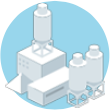
|
(11) Carbon recycling and materials industry |
・ CO2-absorbing concrete |
・PVC recycling |

|
(12) Housing, building industry, and next-generation electric power management industry |
・ ZEH and ZEB (zero energy homes and buildings) |
・PVC (resin window, PVC pipe, wire coating) |

|
(13) Resource circulation industry |
・ CCU (Carbon Capture and Utilization) plants at waste incineration
facilities |
・PVC recycling |
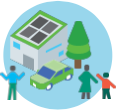
|
(14) Lifestyle-related industries |
・ Total management of housing and transportation (combination and optimization of ZEH, ZEB, demand-side equipment, local renewable energy, electric vehicles and fuel cell vehicles, etc.) |
・PVC (resin window, PVC pipe, wire coating) |
- 1 Source: "Green Growth Strategy Through Achieving Carbon Neutrality in 2050"
(announced by the
Japanese government in
June 2021)
https://www.meti.go.jp/policy/energy_environment/global_warming/ggs/index.html - 2 Future products are included. The colors of the letters of products and
technologies indicate
business segments.
【Business segments】 Infrastructure Materials Electronics Materials Functional Materials Processing, Trading & Specialized Services - 3 Semiconductor materials refer to silicon wafers, photoresists, mask blanks, sealing materials, pellicles, synthetic quartz, high-purity silane, etc. Semiconductor materials fall under the semiconductor industry in field (6), but semiconductors manufactured using semiconductor materials contribute to control systems and other applications in a variety of fields, so they are also listed in fields other than (6).
Disclosure of TCFD-Recommended Items
Governance
The Sustainability Committee is working with each of the Group's business divisions to address climate change. The Sustainability Committee is one of the committees for each material management task in the Group's corporate governance system. Chaired by the president, the committee consists of about 60 members, including directors, corporate officers and divisional managers of Shin-Etsu Chemical, as well as persons in charge of sustainability at Group companies, and develop initiatives that integrate business and sustainability initiatives.
Sustainability > Management > Structure of Sustainability Initiatives
In FY2021, we established a Carbon Neutral Task Force within the Committee to examine each issue related to climate change. The Task Force held a general meeting every three months and reported the latest information to the president, who received this report and decided on a policy. Based on this policy, the Task Force conducted investigations and deliberations, and reported on climate change-related initiatives at meetings of the Managing Directors’ Meeting and the Board of Directors attended by all directors, audit & supervisory board members and corporate officers. After these efforts, we formulated a plan to achieve carbon neutrality in 2050 and announced it at the end of May 2023.
Strategy
The Group considers the promotion of plans to achieve carbon neutrality by 2050 as an important management issue. While promoting information disclosure based on the TCFD recommendations, including scenario analysis, we identify important risks and opportunities that affect our business through these analyses, and reflect them in our management.
Senario analysis
In FY2021, we conducted a scenario analysis of some of our businesses to identify the risks and opportunities that climate change poses to our business activities.
1) Assumed scenarios
Considering the impact of climate change, we have assumed scenarios for a 1.5°C rise and a 4°C rise for the year 2050.
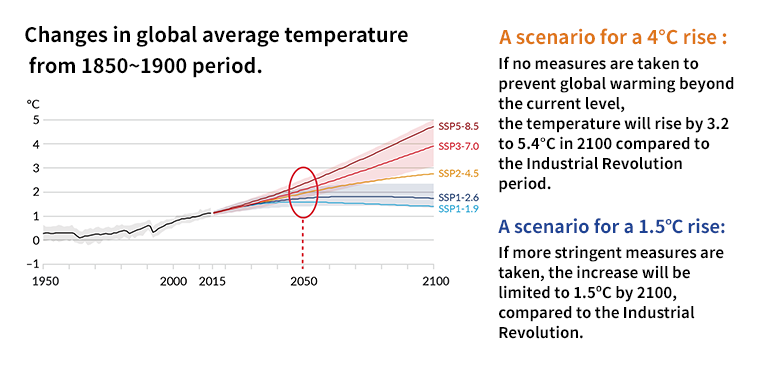
Source: Sixth Assessment Report, Intergovernmental Panel on Climate Change (IPCC)
| Event | 1.5ºC scenario | 4ºC scenario |
| Extreme high temperatures on land areas | The frequency of extreme high temperatures (+1.9ºC compared to 1850–1900) on a once-in-a-decade scale will increase 4.1 times in 2081–2100. | The frequency of extreme high temperatures (+5.1ºC compared to 1850–1900) on a once-in-a-decade scale will increase 9.4 times in 2081–2100. |
| Heavy rainfall on land | The frequency of extreme wetting (+10.5% compared to 1850–1900) on a once-in-a-decade scale will increase 1.5 times in 2081–2100. | The frequency of extreme wetting (+30.2% compared to 1850–1900) on a once-in-a-decade scale will increase 2.7 times in 2081–2100. |
| Global mean sea level | Compared to the 1995–2014 average, global mean sea level will increase by 28 cm to 55 cm by 2100. | Compared to the 1995–2014 average, global mean sea level will increase by 63 cm to 101 cm by 2100. |
| Percentage of renewable energy in power supply composition | Renewable energy ratio will account for 90% of total electricity generation in 2050. | |
| Financial impact | Economic slowdown due to the introduction of the carbon tax and the impact of higher electricity prices on corporate profits. | Economic stagnation and increased insurance premiums due to severe wind and flood damage. |
- Source:
- Sixth Assessment Report, Intergovernmental Panel on Climate Change (IPCC)
- International Energy Agency (IEA) "Net Zero by 2050"
- Mitsubishi Research Institute "Climate Change Response / Environmental Disclosure (TCFD)"
① Business opportunities arising from climate change: A scenario for a 1.5°C rise
| Applications | Details | Revenue Impact |
| Resin windows |
|
Large |
| Electric vehicles, hybrid vehicles, fuel cell vehicles |
Sustainability -Achieving a Sustainable Society -With the environment |
Large |
| Wind power generators |
|
Large |
| Air conditioners |
|
Medium |
| Aircrafts |
|
Medium |
| Motors for industrial use |
|
Medium |
| Robots for services |
|
Medium |
| Binder for plant-based meat alternatives |
|
Medium |
- * From "DRAWDOWN – The Most Comprehensive Plan Ever Proposed to Reverse Global Warming" edited by Paul Hawken
② Business risks due to climate change and countermeasures: 1.5 ℃ scenario (transition risk)
| Events | Risks to the Company | Impact | Countermeasures |
| Introduction of carbon taxes and establishment of carbon emission quotas around the world |
|
Large |
|
| Widespread use of electricity derived from renewable energy sources and rising electricity prices resulting from tightening regulations on greenhouse gas emissions |
|
Large |
|
③ Business risks due to climate change and countermeasures: 1.5°C scenario (Physical risk)
| Events | Risks to the Company | Impact | Countermeasures |
| Increase in the frequency of extreme weather events |
|
Large |
|
| Increased frequency of flooding caused by changes in precipitation patterns, etc. | |||
| Introduction of carbon taxes and establishment of carbon emission quotas in some countries |
|
Small |
|
| Electricity price |
|
ー | ー |
Risk management
The Risk Management Committee works to prepare for and eliminate the various risks surrounding our
business, including
risks posed by climate change. The Committee is chaired by a managing corporate officer and consists
of approximately 20
members, including our directors, corporate officers, and department managers.
Our Group has
established Risk Management Regulations to identify potential risks associated with our business
activities and address these risks appropriately. The Risk Management Regulations clearly state
specific risks, risk
management systems, and responses to risks that materialize. The Risk Management Committee reports
to the Board of
Directors, Managing Directors’ Meeting, Audit & Supervisory Board, and relevant parties in a timely
manner on important
risk management issues, and works to address them appropriately.With regard to the risks related to climate change, which have become increasingly important in recent years, the Sustainability Committee works with the Risk Management Committee to ascertain risks through scenario analysis.
Sustainability > Management > Risk management
Climate-related physical risks include increased spending due to CO2 emissions trading and carbon taxes, transition risks such as rising manufacturing costs due to rising energy prices, damage to equipment due to the wind disaster, and damage to electrical equipment due to flooding, or plant shutdown resulting from such cases. Among these risks, we defined serious risks such as accidents, explosions, fires, and other major disasters that cause operations to be stopped for one day or more, and environmental pollution incidents that exceed legal standards values or regulation values.
Metrics and Targets
The Shin-Etsu Group aims to achieve net zero greenhouse gas emissions (Scope 1 and 2) by 2050. Furthermore, we will continue to promote the reduction of greenhouse gas emissions in terms of intensity. We will work to achieve the new medium-term target set in FY2016 of “Reduce greenhouse gas emissions in terms of intensity to 45% of the FY1990 level by FY2025.”
Long-term target
Achieve carbon neutrality by 2050 (scopes 1 and 2)
Result in FY2022
6,613 thousand t-CO2 (scope1 2,246 thousand t-CO2, scope2 4,367 thousand t-CO2)
Mid-term target
Reduce greenhouse gas emissions in terms of production intensity to 45% (i.e. down 55%) of the FY1990 level by FY2025.1
Result in FY2022
Acheives reduction to 54.2% (i.e. down 45.8%) for the Shin-Etsu Group2 and 46.8% (i.e. down 53.2%) for Shin-Etsu Chemical.
Changes in Greenhouse Gas Emissions in Terms of Production Intensity
Relative to the FY1990 Level
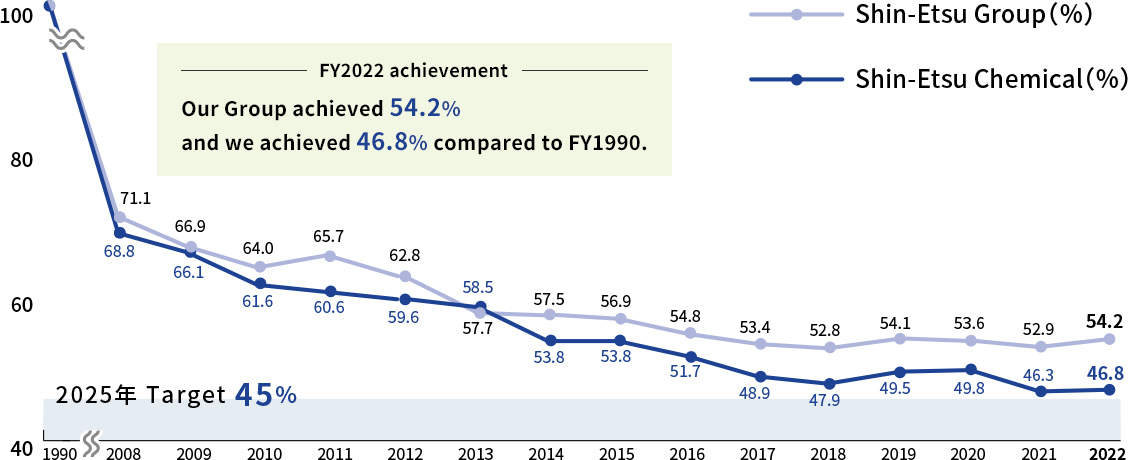
- 1 For the calculation of emissions, CO2 emission factors for electricity are averaged from 2000 to 2009 so that efforts to reduce electricity can be clarified.
- 2Includes non-consolidated group companies.


